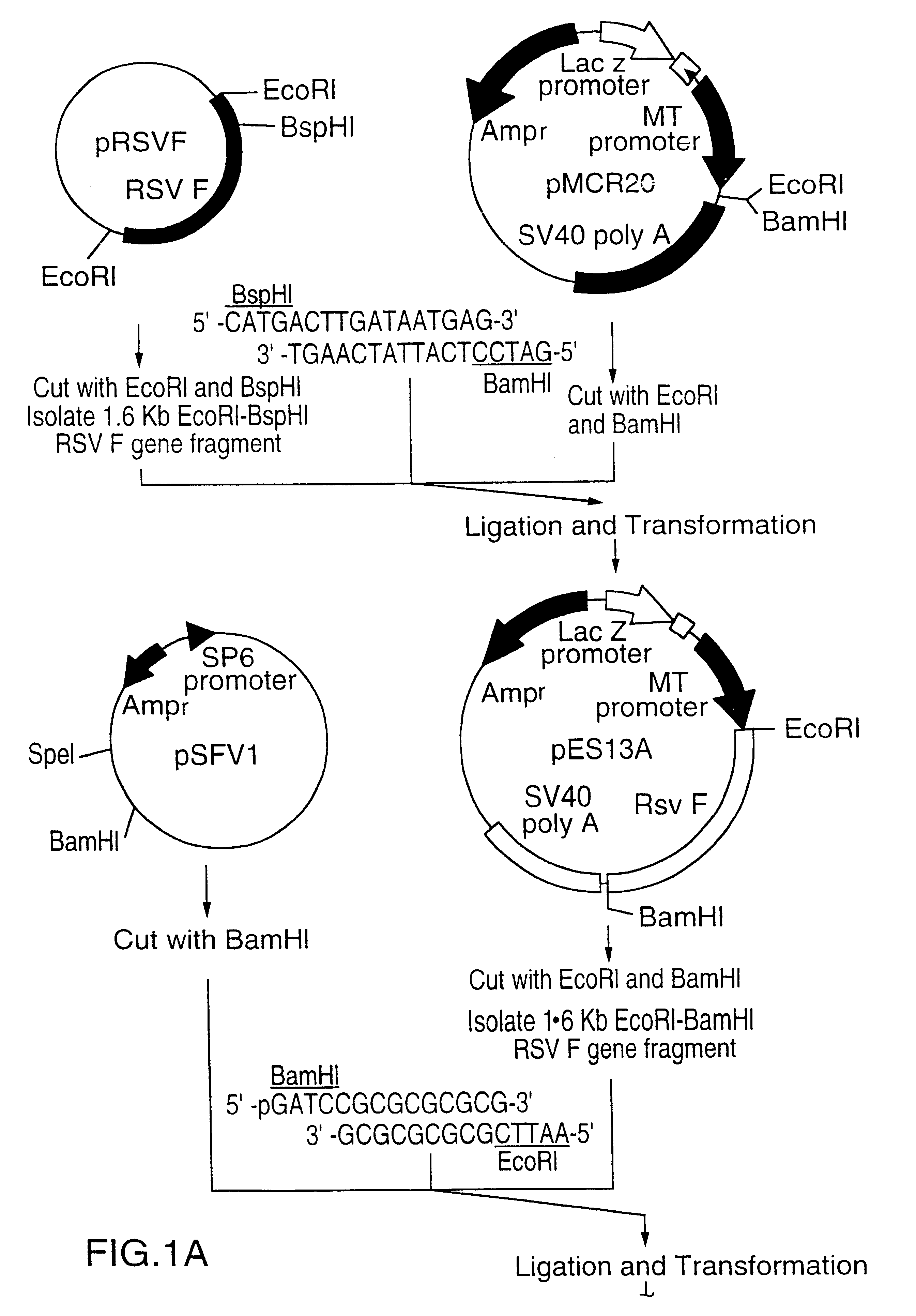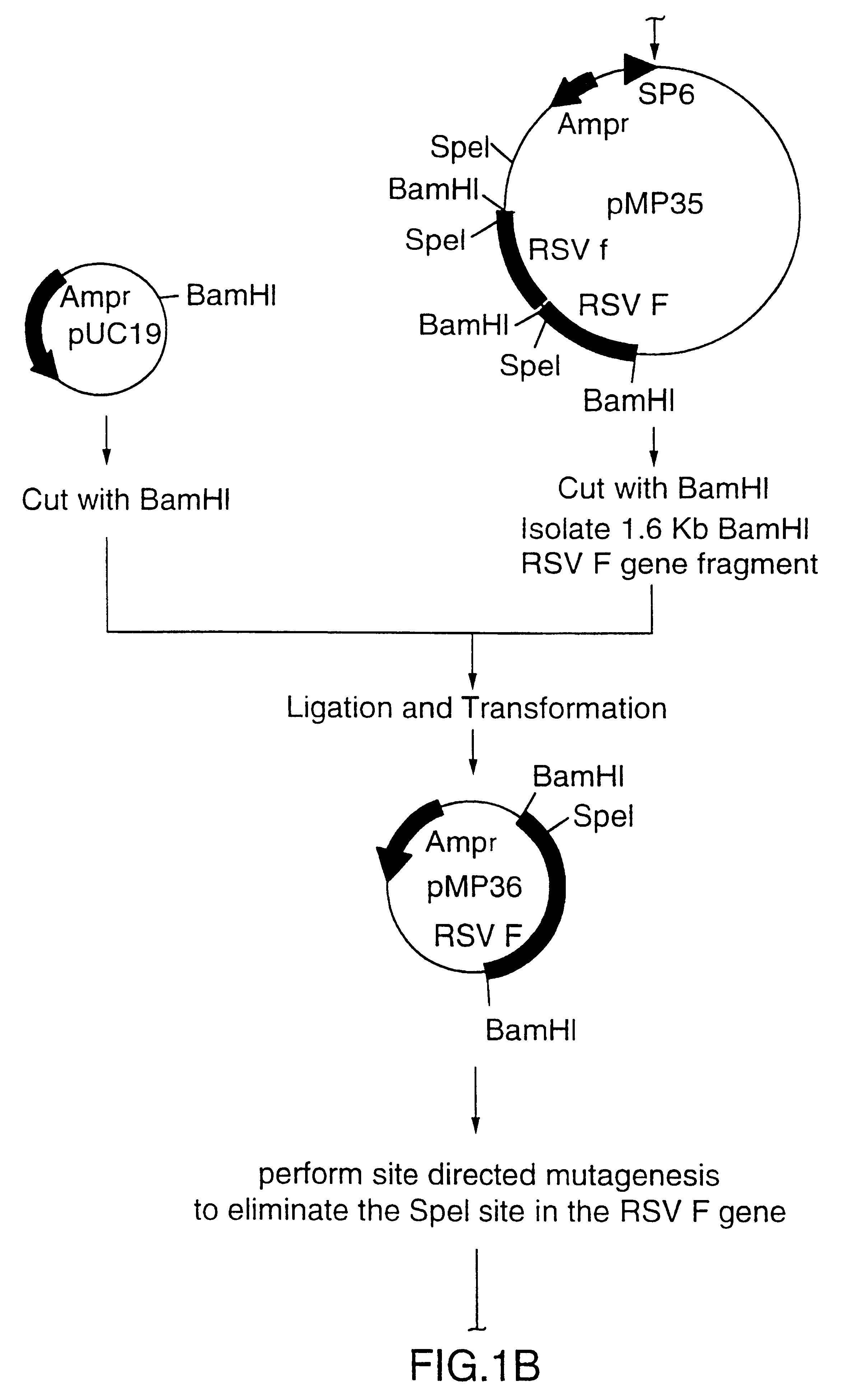RNA respiratory syncytial virus vaccines
a technology of respiratory syncytial virus and vaccine, which is applied in the field of rna respiratory syncytial virus vaccine, can solve the problems of imbalance in cell-mediated responses, inability to fully meet the requirements of large-scale production of vaccines, and inability to provide vaccines
- Summary
- Abstract
- Description
- Claims
- Application Information
AI Technical Summary
Benefits of technology
Problems solved by technology
Method used
Image
Examples
example 1
This Example describes the construction of a Semliki Forest virus (SFV) expression vector containing a truncated version of the RSV F gene.
A truncated version of the RSV F gene was inserted into the SFV expression vector pSFV1 (Gibco BRL, Gaithersburg, Md., USA) according to the steps outlined in FIG. 1. The RSV F gene was originally cloned from a subtype A RSV clinical isolate into plasmid pRSV F, as fully described in copending U.S. patent application Ser. No. 08 / 001,554 filed Jan. 6, 1993, assigned to the assignee hereof and the disclosure of which is incorporated herein by reference, (ref. 41 and WO 93 / 14207). A fragment of the RSV F gene was excised from plasmid RSV F by digesting the plasmid with BspHI and EcoRI. The restriction enzyme BspHI cuts within the RSV F gene coding region, removing 48 amino acids from the C-terminus of the F protein. These amino acids make up most of the transmembrane domain and the entire cytoplasmic tail. The resulting 1.6 Kb truncated RSV F gene f...
example 2
This Example describes the preparation of SpeI linearized pMP37 required for the generation of SFV-RSVF RNA in in vitro transcription reactions and the preparation of SFV-RSVF RNA.
20 .mu.g of plasmid pMP37, prepared as described in Example 1, was cut with SpeI in a 100 .mu.L reaction containing 20 MM Tris-HCl (pH 7.4), 5 mM MgCl2, 50 mM KCl and 30 units of SpeI (Gibco BRL, Gaithersburg, Md., USA).
SFV-RNA was generated from the linearized plasmid in a 300 .mu.L in vitro transcription reaction using of the following materials
40 mM Tris-HCl (pH 7.9)
6 mM MgCl.sub.2
2 mM spermidine-(HCl).sub.3
1 mM DTT (dithiothreonol)
1 mM ATP (adenosine triphosphate)
1 mM GTP (guanosine triphosphate)
1 mM CTP (cytidine triphosphate)
1 mM UTP (uridine triphosphate)
1 mM m.sup.7 G(5')ppp(5')G RNA cap analog (New England Biolabs, Mississauga, Ont., Canada)
360 units of RNasin.RTM. enzyme inhibitor (Promega, Madison, Wis., USA)
270 units of SP6 RNA polymerase (Gibco BRL, Gaithersburg, Md., USA)
The reaction was incu...
example 3
This Example describes the immunization of mice with SFV-RSVF RNA and the immunogenicity results obtained.
It has previously been shown that mice are susceptible to infection with RSV (ref. 42) and are a relevant animal model. The mice were immunized with the SFV-RSVF RNA prepared as described in Example 2, by the intramuscular (i.m.) route. The anterior tibialis muscles of five BALB / c mice (female 6 to 8 week old) (Jackson Lab., Bar Harbour, Me., USA) were bilaterally injected with 2.times.25 .mu.g (0.5 .mu.g / .mu.L) of the PBS-directed SFV-RSVF RNA. Five days prior to RNA immunization, the muscles were treated with 2.times.50 .mu.L of cardiotoxin (10 .mu.M in PBS) (Latoxan, France). Treatment of muscles with cardiotoxin has previously been shown to enhance the uptake of DNA and enhance the immune response (ref. 43). These mice were boosted in an identical manner 4 weeks later (Table 1 below). The control groups were immunized with (1) SFV RNA expressing .beta.-galactosidase (SFV-Lac...
PUM
| Property | Measurement | Unit |
|---|---|---|
| pH | aaaaa | aaaaa |
| concentration | aaaaa | aaaaa |
| resistance | aaaaa | aaaaa |
Abstract
Description
Claims
Application Information
 Login to View More
Login to View More - R&D
- Intellectual Property
- Life Sciences
- Materials
- Tech Scout
- Unparalleled Data Quality
- Higher Quality Content
- 60% Fewer Hallucinations
Browse by: Latest US Patents, China's latest patents, Technical Efficacy Thesaurus, Application Domain, Technology Topic, Popular Technical Reports.
© 2025 PatSnap. All rights reserved.Legal|Privacy policy|Modern Slavery Act Transparency Statement|Sitemap|About US| Contact US: help@patsnap.com



